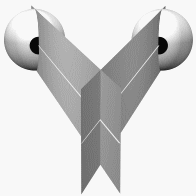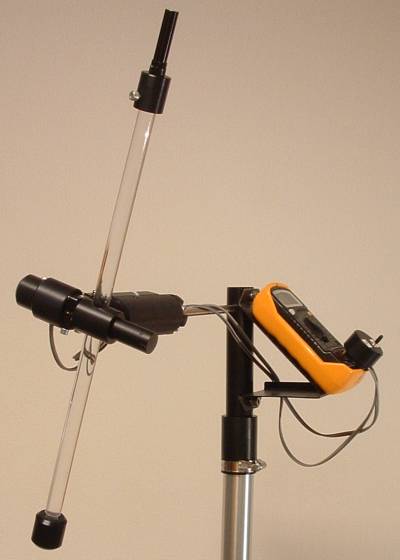Torsions and deviations in pitch and roll

 Perspective representions of planes projected from imaginary vertical retinal meridians onto a mid-sagittal convergence point. Note that the planes intersect in a straight line. Torsion of the eyes will cause the intersection line to alter its orientation in space. The left figure shows symmetrical conjugate torsions, which make the line of intersection tilt in the roll plane only. The right figure shows symmetrical disjugate torsions, which make the line of intersection tilt in the pitch plane only.
Perspective representions of planes projected from imaginary vertical retinal meridians onto a mid-sagittal convergence point. Note that the planes intersect in a straight line. Torsion of the eyes will cause the intersection line to alter its orientation in space. The left figure shows symmetrical conjugate torsions, which make the line of intersection tilt in the roll plane only. The right figure shows symmetrical disjugate torsions, which make the line of intersection tilt in the pitch plane only.
Pitch and Roll Test
 The device illustrates the principle of assessing subjective deviations in roll and pitch: a test rod is mounted so that it can be tilted in both directions.
The device illustrates the principle of assessing subjective deviations in roll and pitch: a test rod is mounted so that it can be tilted in both directions.
The self-illuminated transparent test rod is 0.4 m long and placed 0.4 m from the subject's eyes, with the center of rotation at eye level, and the roll axis in the mid-sagittal plane. The test task is to grip the rod's lower end with the preferred hand and adjust the rod to apparent verticality. The rotation angles can be read from the electronic display. The device is mounted on a camera tripod.
When used in a lighted environment, normal subjects and patients can easily adjust the rod to near perfect vertical in both pitch and roll. The test task is more difficult in darkness and more difficult in pitch than in roll: normal limits are ±4° in pitch and ±3° in roll.

 Perspective representions of planes projected from imaginary vertical retinal meridians onto a mid-sagittal convergence point. Note that the planes intersect in a straight line. Torsion of the eyes will cause the intersection line to alter its orientation in space. The left figure shows symmetrical conjugate torsions, which make the line of intersection tilt in the roll plane only. The right figure shows symmetrical disjugate torsions, which make the line of intersection tilt in the pitch plane only.
Perspective representions of planes projected from imaginary vertical retinal meridians onto a mid-sagittal convergence point. Note that the planes intersect in a straight line. Torsion of the eyes will cause the intersection line to alter its orientation in space. The left figure shows symmetrical conjugate torsions, which make the line of intersection tilt in the roll plane only. The right figure shows symmetrical disjugate torsions, which make the line of intersection tilt in the pitch plane only.
 The device illustrates the principle of assessing subjective deviations in roll and pitch: a test rod is mounted so that it can be tilted in both directions.
The device illustrates the principle of assessing subjective deviations in roll and pitch: a test rod is mounted so that it can be tilted in both directions.